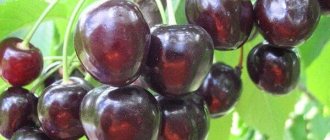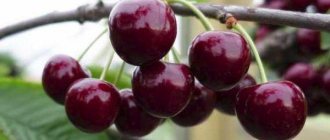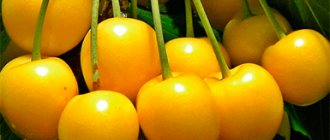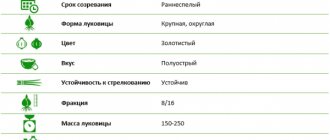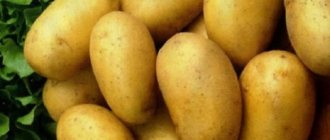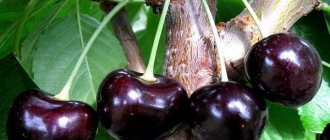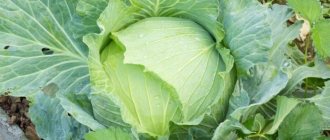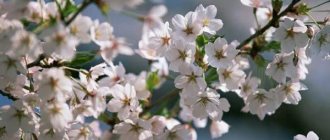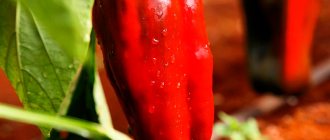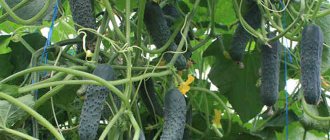Description of the variety
Cherry fruits Fairy Tale
Many summer residents and gardeners prefer the Skazka cherry variety, noting the unique taste properties of the fruit and the winter hardiness of the seedlings. The ripe fruit has a characteristic garnet-red hue (sometimes even black) and a very sweet taste. The pulp is homogeneous, fairly dense consistency.
Skazka is one of the relatively new varieties of cherries, bred quite recently. It was obtained by crossing varieties such as Valery Chkalov and Drogana Zheltaya. As a result, breeders received a new “black” cherry variety, with large fruits, the weight of which can reach 14 g or even more.
The fruits ripen relatively early, which is very beneficial for professional gardeners selling berries. Already in May you can safely harvest. Skazka is considered one of the high-yielding varieties. In the third year, the gardener will be pleased with a harvest of approximately 3-5 kg, the fourth 20-25 kg, and the fifth – up to 30 kg of aromatic deep red berries.
The best early varieties of cherries with descriptions and photos
Many people love cherries, so they are grown everywhere in gardens and dachas. This culture is not picky, but it will not tolerate a disdainful attitude. It needs regular watering, pruning, fertilizing, and sometimes insulation for the winter. Early varieties of cherries: white and red, productive and large-fruited will be described below in the article.
What are the features of early varieties of cherries?
Early varieties of cherries are the most famous and popular trees for planting, because they produce early harvests. Early fruiting makes life easier for the gardener - you can quickly prepare for the winter, sell a lot more berries, and also eat plenty of cherries and replenish your supply of vitamins for the coming months!
But besides the ripening period, are there any common characteristics among early varieties of cherries? There is one common similarity that every gardener should know about. Typically, all such trees require a pollinator tree to grow nearby. Without it, there will be either very little fruit or no fruit at all.
It is necessary that a pollinating tree grow nearby
Otherwise, these species are too diverse: color, berry size, yield, type of cultivation and characteristics can be completely different. One can, perhaps, note their endurance to returning colds, but not all gardeners will agree with this, because it is the early varieties of cherries (flowers and buds on them) that often freeze out during spring frosts.
Which early cherry varieties have high yields?
Productivity is the first thing that is important if early varieties of cherries are planted for a large family, with an abundance of relatives and friends, or for sale. 20-30 kg of harvest from one tree is not enough in these cases, so it is worth choosing more productive varieties of early cherries
- “Homestead” annually produces up to 85 kg of berries per tree. Fruiting begins from 5-6 years, the berries ripen from the beginning of June. The tree grows up to 4 meters, the crown is not very thick, rounded. Berries up to 5.5 grams, with soft, creamy pulp. The color of the berries is yellow, with a rich red blush. Transportability is high. Pollinators: “Vinka”, “Skorospelka”, “Valery Chkalov”.
- “Iput” can provide a family with 60-80 kg of cherries per tree in one season. Its berries are not very large, the weight rarely reaches 8 grams, the color is burgundy, and the shape is heart-shaped. It bears fruit from the 5th year, but large harvests should be expected only from the 7th-8th year, not earlier. The harvest begins in mid-June. Cherries of the varieties “Ovstuzhenka”, “Bryanskaya Rozovaya”, “Tyutchevka”, “Raditsa”, “Revna” are suitable as pollinators. A tree with a wide crown grows.
Early varieties of cherries with high yields
Large varieties of cherries
Early varieties of cherries can be divided into small-fruited, medium-fruited and large-fruited. Of course, the latter are the most convenient for eating and processing. Also, it is the large varieties of cherries that attract buyers at the market and in stores and can be sold at a higher price.
- “Farewell” has a yield of 60 kg per tree annually with good care. The tree is of medium height, spreading crown, with an abundance of foliage. Bears fruit from 4-5 years, fruit ripening is mid-June. The berries are dense, large – 14 grams, dark red. The taste is sweet-wine, the aroma is strong. Transportability is high. Pollinators: “Donetsk beauty”, “Donetsk coal”.
Large varieties of early cherries
Early varieties of yellow cherries
Early varieties of cherries with yellow berries do not have a very high price on the market, as they quickly deteriorate. But if you grow them in your own garden, you can get not only good berries for canning, but also an abundance of vitamins, because yellow cherries are very beneficial for the body.
Early varieties of yellow cherries
- “Chermashnaya” has a tall tree with a thick, elongated crown. The berries are up to 5 grams yellow and ripen from the beginning of June. The pulp is fleshy, with a large amount of juice and a honey aftertaste. The pit is separated without problems, which simplifies processing. It tolerates diseases and frosts easily. Pollinators: “Iput”, “Bryanskaya pink”, “Fatezh”, “Leningradskaya black”.
- “Mlievskaya yellow” is an early cherry variety that ripens from mid-June. The berries are 5-6 grams, yellow, with shiny skin. The main difference between this variety is that it does not require pollinators. Winter hardiness is average. The first fruiting can be expected for 4-5 years. Suitable for processing and fresh consumption.
- “Dachnitsa” ripens from mid-June. The berries are light yellow, weighing 7-11 g, heart-shaped. The bone is well separated from the pulp. Fruits from 4 years old. The tree grows low, the crown is spreading. Pollinators: “Talisman”, “Drogana yellow”, “Melitopolskaya”.
Selection and planting of seedlings
Cherry seedlings of the Skazka variety, just like other varieties, are recommended to be planted in spring or autumn.
It is important that the air temperature is firmly established at the positive mark, otherwise there is a high risk of seedling death. It is recommended to choose planting sites protected from the wind.
If you intend to plant a tree near buildings and structures, it is better to choose a sunny, south-facing location.
Cherries love the sun and light very much, so on the shady side they can quickly die or not produce a harvest.
Rules of care
Planting a cherry seedling
This variety is not afraid of cold weather, so it can be safely grown not only in the southern regions, but also in central Russia, as well as in Ukraine.
The tree must be watered and fertilized with phosphorus fertilizers in preparation for the winter season. It is easy to care for, is not afraid of parasites, and is resistant to most diseases that often affect fruit and berry trees.
Care should include a clear watering schedule, approximately 10 liters of water per tree:
- the first - in the spring before the buds open;
- the second - two weeks after flowering;
- third - two weeks before harvesting the fruits;
- the fourth - in October-early November.
Reviews from gardeners
Cherry branch Fairy tale
The Skazka variety is becoming increasingly popular among summer residents and gardeners. If you carefully study their reviews regarding this variety, you will notice that almost everyone notes such qualities as:
- unpretentiousness and high degree of survivability of seedlings;
- possibility of growing in the middle zone;
- high resistance to cold;
- early harvest;
- high productivity;
- excellent taste and high demand in the market.
You can read about the Ovstuzhenka cherry variety here.
You may also find this article useful on how to care for cherries.
On average, the life and fruiting period of the variety ranges from 90-110 years. The fruits tolerate transportation well and are stored well frozen.
How to prune one-year-old cherries correctly, see this video:
Description of the winter-hardy cherry Tale: selection of seedlings, planting and care rules
Cherry fruits are a favorite delicacy of most residents of the middle and southern zone. Over the past 15 years, over 80 varieties of cherries have been developed, each of which has unique taste and properties.
One of these varieties is Skazka, distinguished by large honey-sweet fruits of a rich red color.
Description of the variety
Cherry fruits Fairy Tale
Many summer residents and gardeners prefer the Skazka cherry variety, noting the unique taste properties of the fruit and the winter hardiness of the seedlings. The ripe fruit has a characteristic garnet-red hue (sometimes even black) and a very sweet taste. The pulp is homogeneous, fairly dense consistency.
Skazka is one of the relatively new varieties of cherries, bred quite recently. It was obtained by crossing varieties such as Valery Chkalov and Drogana Zheltaya. As a result, breeders received a new “black” cherry variety, with large fruits, the weight of which can reach 14 g or even more.
The fruits ripen relatively early, which is very beneficial for professional gardeners selling berries. Already in May you can safely harvest. Skazka is considered one of the high-yielding varieties. In the third year, the gardener will be pleased with a harvest of approximately 3-5 kg, the fourth 20-25 kg, and the fifth – up to 30 kg of aromatic deep red berries.
Selection and planting of seedlings
Cherry seedlings of the Skazka variety, just like other varieties, are recommended to be planted in spring or autumn.
It is important that the air temperature is firmly established at the positive mark, otherwise there is a high risk of seedling death. It is recommended to choose planting sites protected from the wind.
If you intend to plant a tree near buildings and structures, it is better to choose a sunny, south-facing location.
Cherries love the sun and light very much, so on the shady side they can quickly die or not produce a harvest.
Rules of care
Planting a cherry seedling
This variety is not afraid of cold weather, so it can be safely grown not only in the southern regions, but also in central Russia, as well as in Ukraine.
The tree must be watered and fertilized with phosphorus fertilizers in preparation for the winter season. It is easy to care for, is not afraid of parasites, and is resistant to most diseases that often affect fruit and berry trees.
Care should include a clear watering schedule, approximately 10 liters of water per tree:
- the first - in the spring before the buds open;
- the second - two weeks after flowering;
- third - two weeks before harvesting the fruits;
- the fourth - in October-early November.
Reviews from gardeners
Cherry branch Fairy tale
The Skazka variety is becoming increasingly popular among summer residents and gardeners. If you carefully study their reviews regarding this variety, you will notice that almost everyone notes such qualities as:
- unpretentiousness and high degree of survivability of seedlings;
- possibility of growing in the middle zone;
- high resistance to cold;
- early harvest;
- high productivity;
- excellent taste and high demand in the market.
You can read about the Ovstuzhenka cherry variety here.
You may also find this article useful on how to care for cherries.
On average, the life and fruiting period of the variety ranges from 90-110 years. The fruits tolerate transportation well and are stored well frozen.
How to prune one-year-old cherries correctly, see this video:
Description of culture
Early cherry Skazka, due to its good cold resistance, is recommended for cultivation both in the southern territories and in the conditions of central Russia.
The glossy fruits have a round, slightly elongated shape and are colored a rich garnet-red color, sometimes very dark, almost black. The homogeneous pulp with a dense juicy consistency has a pleasant sweet taste with a hint of honey. The Skazka variety is especially valuable because of its rather large size and weight of up to 12 grams. The bone is small.
Read also: Preparing apple trees for winter: how to cover and insulate, step-by-step guide with photos
The average height of the Skazka cherry tree is 3.5 – 4 meters. As it grows, it forms a dense crown with a characteristic pyramidal shape.
Oval leaf blades with sharp tops and jagged edges have a slightly wrinkled surface. Their various shades provide the tree with a high degree of decorativeness throughout the entire growing season.
Description
Let's find out what distinctive characteristics the variety has.
Selection
Cherries were bred in Ukraine - at the Melitopol Breeding Institute. Thanks to its proximity to our country, the plant turned out to be adapted to the weather conditions of not only Ukraine, but also Russia: The fairy tale is grown by many southern gardeners.
The variety was obtained by crossing two types of cherries:
- Valery Chkalov;
- Drogana Yellow.
O has greatly improved the performance of her “parents”, surpassing them in almost all respects. The variety can be grown both in the south and in the middle zone: it turned out to be quite cold-resistant.
Plant characteristics
- The tree reaches a height of 3.5-4 meters.
- The crown is dense, pyramidal - a characteristic shape for this fruit species.
- The leaves are oval with pointed tips, their edges have small teeth.
- An interesting feature is the different shades of green in the color of the leaves. This gives the plant a decorative appearance, even when it does not bloom or bear fruit.
Fruit characteristics
- The Skazka cherry produces round fruits with a slightly elongated shape.
- Their color is rich garnet, often reaching dark burgundy.
- The pulp is of uniform consistency, very dense and juicy.
- The taste is sweet, pleasant, has honey notes.
- The sizes are large, the weight reaches 12 grams.
- Small bone.
Stability characteristics
Cherry Skazka is a plant of average frost resistance. The tree will tolerate cold temperatures down to -25 degrees, but if the winters are more severe, it will have to be covered. In the spring, you should carefully watch so that the fruit buds do not freeze out from insidious return frosts.
As for drought resistance, this indicator is also at an average level. Watering is required, especially in hot weather without rain.
Immunity
Resistance to infections is above average. Even if the summer is wet, fungal diseases rarely affect cherries. Pests also rarely attack a fruit tree, which allows you to get by with minimal preventive measures and get an environmentally friendly harvest.
Pollination, ripening time
The variety is self-fertile, so planting pollinators nearby is mandatory to obtain good yields. The following varieties of cherries are optimal for this purpose:
- And the way;
- Ovstuzhenka;
- Tyutchevka.
Flowering of “Fairy Tale” and all of the listed pollinators occurs in the middle to second half of April. Fruiting, therefore, is early: in May you can already begin to harvest.
Yield characteristics
At the age of five, young cherries begin to bear fruit. At first, the level of fruiting is low: the tree produces 5-7 kg of berries in the first years. But as they grow older, the yield becomes higher: a mature, developed tree produces 30 kg of fruit, on average.
Productivity also depends on proper care. The more carefully the agricultural techniques are followed, the more fruits you can collect.
Harvest Application
Since the berries are very juicy, they should be picked carefully to avoid deformation. Fresh fruits are very tasty. They are also suitable for preparation; they are used for cooking:
- compotes;
- confitures;
- jelly;
- jam;
- marmalade.
Characteristics
The large-fruited Skazka cherry, being a successful result of targeted selection, has received improved characteristics of its predecessors.
Drought resistance, winter hardiness
The tree easily tolerates temperatures down to -25˚C, which makes the Skazka cherry popular in areas with unstable climatic conditions in the center of Russia.
For flowering cherries, severe night frosts can pose a danger, negatively affecting the buds.
With good indicators of drought resistance, the crop requires timely watering, which has a beneficial effect on the activation of fruiting.
Pollination, flowering period and ripening time
Since the Skazka cherry is a representative of self-sterile varieties, when breeding it, it is necessary to provide for the placement in the vicinity of varieties that can provide the pollination necessary for the formation of large berries.
Pollinators suitable for the growing season for the Skazka cherry are Tyutchevka, Ovstuzhenka, Iput.
In warm climates, flowering trees decorate the garden already in mid-April. Gardeners are attracted by such a characteristic of the Skazka cherry variety as early fruiting. Fragrant ripe berries begin to be picked from the branches in May.
Productivity, fruiting
Planted seedlings of the Skazka variety begin to bear fruit at the age of five. From young trees you can remove 5 kg of fruit.
As the fruit crop develops, the yield increases. An adult Skazka cherry plant produces an average of 30 kg of excellent large berries.
Area of application of berries
The collection of fully ripe Skazka cherries is carried out with care to avoid deformation of the juicy drupes.
They are consumed fresh, appreciating the piquant honey sweetness. They are most often prepared in the form of compotes, jams, jelly, and marmalade.
Resistance to diseases and pests
The Skazka cherry, even under unfavorable conditions with high atmospheric humidity, demonstrates good resistance to infections characteristic of this fruit crop.
This variety is rarely affected by pests, which allows for a stable annual harvest.
Advantages and disadvantages
Gardeners who have experience growing early cherries Skazka appreciate its many advantages:
- winter hardiness;
- the excellent taste of dense honey berries, distinguished by their large dimensions and spectacular dark skin with a pomegranate tint;
- fairly abundant and stable yield;
- good transportability;
- resistance of berries to cracking;
- rare damage by harmful insects and diseases.
A minor disadvantage of this fruit crop is the need to plant a number of pollinating varieties.
Description and characteristics of culture
Cherry Tale was created by scientists from the Melitopol Institute of Irrigated Horticulture, which in itself says a lot.
To develop a new variety, breeders crossed Valery Chkalov with Drogana yellow, and, what is especially surprising, the result was a tree that bears fruit a week earlier than the early ripening Valery Chkalov (note that Drogana yellow is a late-ripening variety).
Did you know? Six out of ten cherries growing on the ground belong to varieties of Melitopol selection, and if we talk about young trees, then all eight. In total, this institute has bred more than 40 varieties of cherries, and all of them occupy leading positions in the world.
In addition to the south of Ukraine, where climatic conditions are considered most suitable for cherries, Skazka has gained great popularity and has taken root throughout the rest of the country, as well as in the south and partly in the middle zone of the European part of Russia and even in the North Caucasus.
Description of the tree and fruits
Fairy tale - the tree is quite tall; in adulthood it reaches a maximum height of 3.5–4 m, although it does not grow very quickly. The crown is very thick, depending on the method of formation, it can be pyramidal or spherical. The leaves are slightly rough, oval, jagged at the edges. The color of the foliage can be represented by all shades of green - from dark to very light, which is determined by the degree of illumination of each specific leaf.
However, the main distinguishing feature of the variety is its fruits. In Skazka they are even larger than those of the far from small-fruited Valery Chkalov, and at the same time they always have the same size, which is important from the point of view of product characteristics. The average weight is 12.5–14 g, dimensions are about 28 mm.
The shape of cherries is regular, round, but slightly elongated, the skin is dense, and has a very dark, almost black color. The pulp is juicy, dense, homogeneous, fleshy and even slightly crunchy when bitten. The juice is dark red, the taste is very sweet, with notes of honey and slight sourness, making it perfectly balanced. The stone is small and easily separated from the pulp.
Important! In shape and color, the Skazka cherry is very similar to Valery Chkalov, but at the same time it is not only larger, but also sweeter.
Frost resistance and drought resistance
Skazka is distinguished by higher frost resistance than both of its parent forms, but it must be understood that this indicator must be assessed taking into account recommendations regarding the zoning of the variety. Thus, the tree perfectly tolerates temperatures dropping in winter to -25°C - this is quite enough for growing the crop in the south of Ukraine, where it was bred, but from the point of view of a resident of the middle zone it may not be sufficient.
However, the advantages of the variety include its good immunity and the ability to quickly recover after wood freezes, if this happens. Nevertheless, returning spring frosts, coinciding with the flowering period of the variety, can cause significant damage not so much to the tree itself as to the potential harvest.
The tasting rating of the fruit is 4.5 on a five-point scale. Universal purpose: suitable for fresh consumption and for preparations
The tree does not need regular watering. At the stage of fruit formation, Skazka usually has enough natural soil moisture preserved after winter; later, when fruiting is over, cherries do not depend on regular precipitation. Some gardeners, however, are not so optimistic and rate the variety's drought resistance as very average. But in general, we can say that Skazka is quite suitable for growing with virtually no watering, the only exceptions being young seedlings, as well as cases when the summer is particularly dry and hot.
By the way, it should be noted that along with high drought resistance, Skazka also has very powerful immunity to fungal infections, and therefore the tree tolerates even wet and rainy summers very easily.
Did you know? Interestingly, productivity is perhaps the only indicator in which Skazka is significantly behind its predecessors. Thus, Drogana yellow is capable of producing up to 150 kg of berries on one tree, for Valery Chkalov this figure averages 60 kg, and once a 12-year-old tree of this variety produced a record harvest of 174 kg!
Fruiting and productivity
The tale refers to early ripening varieties. In its native Melitopol, its fruits reach harvest maturity already at the end of the second ten days of May, in more northern regions, and also with late warming, this period may occur 7–10 days later.
The variety enters the fruiting phase in the fifth year of life. During this period, harvests, of course, are small, up to a maximum of 5 kg per tree. But with each subsequent year this figure increases, and starting from the age of eight, Skazka provides the owner with a regular harvest of up to 30 kg of cherries.
However, it can be assumed that, since the variety is quite young, its trees simply have not yet had time to enter the phase of maximum yields, and the information provided will be updated over time
Pollinator varieties
One of the main problems that a gardener will have to face when growing Skazka is the self-sterility of the variety. Thus, to obtain full harvests, the tree needs pollinators that coincide with its flowering time (approximately mid-April). As already mentioned, neither Valery Chkalov nor Drogana yellow are suitable for this purpose.
Traditionally, to ensure full cross-pollination within a radius of up to 50 m, one, or better yet, several of the following varieties are planted next to Skazka:
- And the way;
- Bryansk pink;
- Raditsa;
- Tyutchevka;
- Revna;
- Chermashnaya;
- Pink pearls;
- Ovstuzhenka.
Advantages and disadvantages
- The list of advantages of the Skazka variety looks very impressive. You can safely include:
- early ripeness;
- unpretentiousness;
- high resistance to diseases and pests;
- drought resistance;
- frost resistance (taking into account recommended growing regions);
- large fruit;
- excellent external and taste characteristics of the fruit;
- stable fruiting and early entry into this phase;
- good transportability;
- lack of tendency to cracking of fruits.
- Among the shortcomings we can only name:
- self-sterility (characteristic of most cherry varieties);
- low winter hardiness for growing in areas with harsh climates;
- relatively low yields.
Landing Features
Although the Skazka cherry is considered an unpretentious crop, when planting it, it is necessary to take into account the characteristics characteristic of this variety.
Recommended timing
Saplings of early ripening cherries Skazka are planted in prepared areas after winter before sap flow. It is important to choose periods when the night temperature does not drop to below zero and the soil has warmed up sufficiently. The advantage is the ability to prepare a young tree for the winter season, so the spring planting season is recommended for central Russia.
Strong, with well-developed rhizomes, Skazka cherry seedlings successfully take root when planted in autumn in warm southern territories. They have time to adapt to new conditions and become sufficiently strong before the winter cold.
Choosing a suitable location
To grow Skazka cherries, select an elevated area that is not subject to flooding. The place should be sunny and have protection from the north.
This crop prefers fertile and loose soil. Cherry Skazka develops poorly on clay soil and poor sandy loam.
What crops can and cannot be planted next to cherries?
To ensure the predicted yield, you should carefully select the plants adjacent to the Skazka cherry.
Cherries, which can participate in the pollination process, bring undoubted benefits. Crops such as rowan and hawthorn do not hinder the development.
It is not recommended to grow raspberries or sloe next to cherries. They create unfavorable conditions for apple, plum, and pear trees. These fruit trees must be at least 6 meters away from the cherries.
Selection and preparation of planting material
Skazka cherry seedlings are carefully inspected at the acquisition stage. They should be free of signs of disease, damage to shoots and bark, and dry branches.
Trees with elastic, developed roots take root well. The buds on the branches should be well defined and dense. The vaccination site is examined. On a viable cherry seedling Skazka it is neat, without sagging or rough cracks.
Read also: Cherry tomatoes: varieties for open ground, low-growing
On the eve of planting, if necessary, shorten the roots slightly and cut out dry shoots. The planting material is kept in a growth stimulant solution for two hours.
Landing algorithm
If you plan to plant several Skazka cherry seedlings, mark the selected area so that there is a gap of at least 3 meters between the trees.
Planting algorithm:
- Before planting cherries, planting holes with a diameter of about a meter and an average depth of 80 cm are prepared 14 days in advance.
- The excavated soil is mixed with rotted compost in equal volumes. Add the same volume of sand to heavy loam. Sandy loam is enriched with organic matter and mineral complex.
- A wooden or metal support is strengthened into the bottom. Lay the drainage and add a little soil substrate, forming a mound.
- Place the cherry seedling vertically, straightening the roots, and fill the hole with the prepared soil mixture in layers, lightly compacting them. Make sure that the root collar is above the surface.
The young tree is tied to a support with soft twine and watered. Mulch with dry humus or leaves.
Landing
Let's get acquainted with the rooting features of the Fairy Tale cherry.
Deadlines
It is best to plant the crop in the spring, choosing the time before sap flow begins in the tissues of the tree. By this time, the night temperature should no longer fall below zero. The soil should have time to warm up.
In the south it is better to plant in the fall: by this time there is a much greater choice of high-quality planting material. And thanks to the warm climate, the cherries will have time to take root before the first frost.
Selecting a location
Choose a site on a slight hill for the Skazka cherry tree: in low-lying areas, flooding of the roots is likely. It is important that the tree is well lit by the sun and has protection from the north wind.
The soil on the site should have a loose structure and be quite fertile. It is better not to plant a tree in a clay substrate, as well as in a depleted, meager one.
Neighbours
In order for the productivity of Skazka cherries to be maximum, you should carefully select neighbors for it. It is optimal to plant other varieties of cherries nearby, which can be pollinators for “Fairy Tale”. Neutral neighbors are:
- hawthorn;
- Rowan.
But we don’t recommend planting thorns or raspberries nearby. Also considered unfavorable neighbors for cherries are:
- pears;
- apple trees;
- plums
There should be a minimum distance of 6 meters from them.
Seedling selection and preparation
At the purchase stage, you should carefully examine the young plant. The following visual signs of illness should be absent:
- rot;
- darkened and dry areas;
- damage;
- defects;
- cracks;
- growths.
A high-quality plant has elastic and well-developed roots. It must have buds that are not dry and do not fall off when pressed.
Be sure to inspect the grafting site: it should be neat and free of any defects or cracks.
Before planting day, the roots should be trimmed and aligned to the same length. In this case, dry roots must be completely removed - they are no longer viable. Immediately before planting, the roots are placed in a stimulant solution for a couple of hours.
Planting process
- The pit is prepared at least two weeks before rooting. The parameters are as follows: length and width are 80 cm, depth is about a meter.
- A drainage layer of crushed stone is formed at the bottom.
- A nutrient substrate consisting of soil, compost, sand, mineral fertilizers and humus is placed in the pit.
- A support is driven into the center of the hole, to which the plant will be tied in the future.
- A small mound is formed next to the peg, on which the seedling is placed.
- The roots of the plant are spread evenly, the hole is filled with nutrient substrate.
- The earth is compacted. After planting, the root collar of the cherry tree should be located above the soil, and not under it.
- The tree is tied to a stake and watered. The root circle is mulched.
Subsequent care of the crop
As part of caring for Skazka cherries, timely watering is organized at least four times during the entire growing season:
- before swelling of the kidneys;
- half a month after flowering;
- 14 days before the planned harvest;
- in early November.
Each tree requires about 10 liters of water.
Young plantings of the Skazka variety are fed with a mineral complex in April. In June, phosphorus-potassium fertilizers are applied. Loose compost is additionally added to mature trees in the fall.
Pre-winter preparation of cherries includes whitewashing skeletal twigs and trunks. Repeat it after the snow melts. To protect young cherries from freezing in the winter, plantings are laid with spruce branches. The salvation from rodents is the compaction of the snow cover around the base of the trunk.
Formative pruning with shortening of shoots by about a third is practiced annually until the buds emerge. Regular sanitary removal of dry, damaged branches is required.
Diseases and pests, methods of control and prevention
If serious violations are allowed in the organization of care, the Skazka cherry tree may experience damage from pests and diseases. In such a situation, effective measures should be taken quickly.
Photo and description of the Skazka cherry variety
The Skazka variety has the following characteristics:
- Self-sterility.
- The crown of the formed tree is dense and pyramidal.
- The leaves are oval with serrated edges and a rough surface. Shades of the main green color give it some decorativeness.
- The fruits are spherical, slightly elongated. The color is garnet red, almost black in low light. The pulp has a dense, homogeneous composition. The taste is sweet with a honey aftertaste. The bone is small. Fruit weight 12 g.
The advantages of the Skazka variety are as follows:
- winter hardiness;
- large fruits;
- fruit flavors with a honey tint;
- stable yield;
- resistance to diseases.
The disadvantage of the Tale cherry is represented by the need to plant other varieties of cherries nearby for complete pollination of flowers.
Mature tree height
Skazka belongs to the category of medium-growing varieties. The height of a fully formed tree is between 3.5-4 meters.
Flowering and ripening period
Early variety Skazka. Subject to average seasonal climatic conditions, it begins to bear fruit in May. Cold spring with periodic frosts of ripening shifts the ripening of fruits by a week.
Productivity
The beginning of active fruiting of Skazka cherries is considered to be five years of age. During this period, up to 5 kg of fruit can be removed from one plant. The average yield of an adult Skazka cherry tree, when growing all the requirements for maintenance and care, is 30 kg.
Transportability
Transportability is good. When collecting and preparing for transportation, care should be taken, since the fruits are juicy and excessive force leads to loss of presentation.
For transportation and temporary storage, use shallow boxes with ventilation holes on the sides.
Drought resistance
The average annual precipitation provides sufficient conditions for the development and fruiting of the tree. During particularly dry periods, Skazka cherries require periodic watering when the soil dries out.
Frost resistance
Cherry Skazka is a frost-resistant variety. Cooling down to -25 0 C does not cause fatal damage, and sharp seasonal changes in temperature remain without consequences, with the exception of the spring flowering period.
Read also: Cherry diseases and the fight against them - photos of coccomycosis, miniliosis, fruit rot, video
Description of the cherry variety Tyutchevka
The Tyutchevka variety was bred at the All-Russian Research Institute of Lupine in Bryansk by crossing varieties 3–36 and Krasnaya dense. In 2001, it was included in the State Register for the Central Region. Why the variety received such an unusual name, history is silent. Perhaps the berries hanging a little sadly in clusters reminded the author of the variety of the sad but beautiful poetry of Fyodor Tyutchev.
Tyutchevka is distinguished by a rich harvest of sweet and juicy berries
Appearance of cherries of the Tyutchevka variety:
- the tree is medium-sized and fast-growing;
- spherical spreading crown of medium density;
- straight and thick brown shoots;
- large dark green leaves with a crenate edge;
- sweet dark red fruits with dense, gristly flesh.
Tyutchevka belongs to the mid-late varieties. The first fruits can be collected 5 years after planting.
Table: advantages and disadvantages of the variety
| Advantages of the variety | Disadvantages of the variety |
|
|
Tyutchevka stores well and can easily be transported
How to plant cherries Fairy Tale
The progressive development of the vegetative system of the tree and the result of fruit harvesting largely depend on the choice of planting site. For Skazka cherries they recommend:
- choose a place with deep groundwater, low probability of flooding in the spring-autumn period;
- direct exposure to northern winds is undesirable;
- refrain from planting in soil with a high content of clay or depleted sandy loam.
How to choose a seedling
The rules for choosing a Skazka cherry seedling are similar to the requirements for other fruit trees:
- You should not purchase specimens with damaged trunk bark or branches.
- Roots and shoots should not be dry or show signs of disease.
- A healthy trunk and root system are resilient.
- The kidneys should be elastic and easily visualized.
Planting dates and scheme
For the Skazka variety, autumn and spring planting of seedlings in the ground is allowed. In the central regions of the country, it is recommended to plant cherries at a time when night frosts have stopped, the earth has warmed up, and the movement of juices has not yet begun. In the south, seedlings with a good root system are planted in mid-autumn. In mild conditions, this gap is enough for complete adaptation before the onset of the first winter cold.
When planting seedlings in the garden, it should be taken into account that individual trees and shrubs adversely affect the growth and productivity of Skazka. You should refrain from being close to raspberries or thorn bushes, and the distance to fruit trees: apple trees, plums, pears should be at least 6 meters.
Pit preparation
Preparatory activities for planting seedlings of Skazka cherry trees are presented as follows:
- Pits. It is recommended to dig planting holes with a diameter of 90 cm and a depth of at least 80 cm in about 14 days, dividing the soil into an accompanying and fertile layer.
- Planting mixture. Mix fertile soil with compost in equal proportions, and loamy soil with sand.
- Support stand. At the bottom of the funnel, near the middle, install a metal rod or wooden block at least 1 meter high.
- To ensure a tight fit of the seedling, a mound is formed in the middle of the hole from a previously prepared mixture. The height should ensure free placement of the root system along its slopes.
The seedling is placed at the planting site, all branches of the roots are carefully straightened. Layers with light tamping are poured to the level of the root collar. Tie the trunk to the support and form a watering ditch.
Caring for Cherry Fairy Tale
From the moment of planting and subsequent time, this variety requires seasonal and preventive care. Activities include timely watering, soil cultivation, fertilizing and control of crown formation.
Feeding and watering
Watering recommendations are presented as follows:
- the first immediately after planting the seedling in the ground – 10-15 l;
- the beginning of kidney swelling;
- two weeks before the time of expected fruit harvest;
- at the end of October–beginning of November.
Fertilizing of Skazka cherries is done:
- mineral complex fertilizers in mid-April;
- phosphorus-potassium additives - when watering in June;
- organic fertilizers - in preparation for the cold season.
Weeding and loosening
Constant removal of weeds and periodic weeding ensure that the horse system is supplied with the maximum amount of moisture, which has a positive effect on the development of the vegetative system and fruiting. The interval is determined visually, depending on the condition of the garden area.
Crown formation
Crown formation is an event aimed at creating comfortable conditions for the growth and development of healthy branches and improving fruiting. Regardless of the season, sanitary removal of dried or damaged branches is necessary. When the juices are actively moving, the cutting sites are treated with garden varnish. The rules and procedure for pruning fruit trees are presented in the following video:
Cherry pollinators Skazka
Since the Skazka variety is self-sterile, when planting, care must be taken to place nearby cherry varieties that are capable of fully and efficiently producing pollination. The flowering periods coincide for the varieties: Tyutchevka, Ovstuzhenka, Iput.
Diseases and pests of cherries Fairy Tale
Cherry Skazka is a disease-resistant variety. But untimely care or massive development of diseases in the breeding area can provoke damage to the vegetative system. The most possible variants of diseases and their symptoms are presented in the following table:
| Disease/pest | Signs | Treatment/prevention |
| Clusterosporiasis | Brown spots turning into grooves on the trunk and branches of the tree. | Spraying with a 1% solution of Bordeaux mixture. |
| Moniliosis | Destruction of buds, rotting of fruits. | Spraying with a 1% copper oxide solution. |
| Coccomycosis | The leaves begin to become covered with brown and red spots. | Spraying after harvesting fruits with Topaz. |
| Black cherry aphid | Curling and drying of leaves. | Spraying with Confidor. |
| cherry fly | Damage to buds and fruits by the vital activity of larvae. | Spraying with Actellik. |
| Leaf rollers | Mass distribution of caterpillars. | Spraying with Chlorophos. |
Advice! Timely implementation of preventive measures reduces the likelihood of illness by an order of magnitude. It is considered sufficient to spray with a 0.5% solution of Bordeaux mixture before the activation of the buds and after harvesting.
